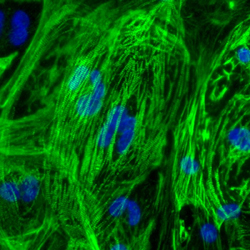

These results suggest that the cccS and cccP genes are involved in the construction of cell surface components in Synechocystis sp. Coxsackievirus B3 (CVB3) is a common enterovirus that causes systemic inflammatory diseases, such as myocarditis, meningitis, and encephalitis. Furthermore, the disruptions reduced the amount of UV-absorbing compound(s) extractable from the exopolysaccharide layer. Both disruptants largely secreted far greater amounts of yellow pigments into the culture medium than did the wild type. Electron microscopy revealed that the cccS disruptant lacked the thick pili responsible for motility and that the cccP disruptant had almost no discernible thick pili on its cell surface. A single cell is often a complete organism in itself, such as a bacterium or yeast. Shorter pili called fimbriae help bacteria attach to surfaces. cell, in biology, the basic membrane-bound unit that contains the fundamental molecules of life and of which all living things are composed. Pili (Pilus singular): Hair-like structures on the surface of the cell that attach to other bacterial cells. Several proteins secreted into the culture medium or retained on the outside of the outer membrane were greatly reduced in both disruptants compared with the wild type. Cell Membrane or Plasma Membrane: The cell membrane surrounds the cell's cytoplasm and regulates the flow of substances in and out of the cell. Disruptants of cccS and cccP showed a more or less similar pleiotropic phenotype. CccS protein was detected in the culture medium and the acid-soluble fraction containing proteins derived from outside the outer membrane. For this study we investigated the localizations of products of slr1667 and slr1668 (designated cccS and cccP, respectively) biochemically and immunocytochemically, and examined the phenotypes of their disruptants. The novelty of transversal interconnections and progressive training in scientific practices provides students with skills in acquiring and understanding new scientific information, even beyond the MCB course.We have previously identified two target genes (slr1667 and slr1668) for transcriptional regulation by a cAMP receptor protein, SYCRP1, in a cAMP-dependent manner. Most students were satisfied since they improved their acquisition of concepts, their interpretation and integration of scientific knowledge, and developed skills to communicate scientific knowledge in writing and orally. Electron microscopy revealed that the cccS disruptant lacked the thick pili responsible for motility and that the cccP disruptant had almost no discernible thick pili on its cell surface. Our teaching proposal was evaluated through the students' academic performance and by their opinion on the teaching methodology. They were assessed by midterm exams based on a primary paper, written laboratory reports, and the oral presentation of a scientific paper. In the third module, the students analyzed a primary paper in‐depth. In the first two modules, the students were prepared to comprehend MCB concepts and techniques and to experience activities based on scientific practices. The methodology was implemented over 4 years, in students attending the MCB course of the undergraduate degree in Biological Sciences. Proteasome inhibitors may delay CCCP-induced cell death caused by excessive Parkin activation by preventing mitochondrial membrane disintegration and cytochrome. We observed rapid recovery of fluorescence in the bleached nucleoplasm, implying that EGFP-Top2A is highly mobile in the nucleoplasm. our new teaching methodology was progressive training in scientific practices associated with a back‐and‐forward interplay between activities and assessments. Without 2DG/CCCP treatment, a small area in the nucleoplasm of an EGFP-Top2A-expressing cell was photobleached (Fig 3a). Our goal was to train students to acquire, understand, and communicate new scientific knowledge in the field. These cells receive information about their surroundings via extracellular biochemical and. Most epithelial cells, migrating cells and developing cells require some form of cell polarity for their function. Even though there are several approaches based on scientific practices, a key aspect is to define the purpose of each of these teaching strategies and, most importantly, their implementation. Cell polarity refers to the intrinsic asymmetry observed in cells, either in their shape, structure, or organization of cellular components. Nowadays Molecular Cell Biology (MCB) must be taught as science is practiced. Acquisition was then stopped, and CCCP (375 M for cells in proliferation and 2 mM for cells in differentiation).


 0 kommentar(er)
0 kommentar(er)
